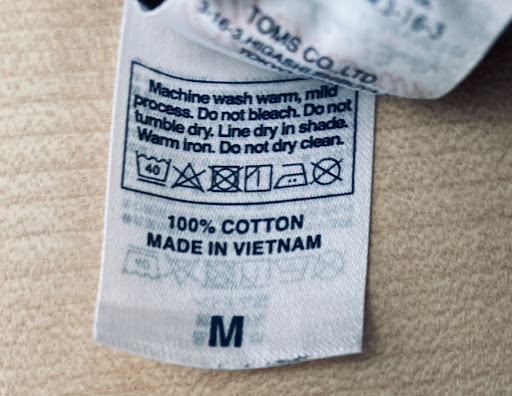
Photo: Miki M. ('22)
Typical labels on hang tags only show the country of the manufacturer of the final product and not the origins of individual materials used.
Designed here, made elsewhere
The manufacturers hidden behind the labels
Typical labels on hang tags only show the country of the manufacturer of the final product and not the origins of individual materials used.
Should we, as consumers, incentivize the world’s biggest brands and retailers to be transparent in crediting all countries who were part of the garment life cycle on their care labels?
In our daily lives, we hardly pay attention to our brand garment labels. We only think of them as those scratchy pieces of fabric, but these labels can play a significant role in helping us purchase clothes ethically. What brands typically do with those labels is list care instructions, size, and in a very small text, where the garment was made. However, there are a lot of countries and people involved in this process who are not given credit for their work. Most, if not all, brands and retail stores do not reveal the countries of manufacturers and suppliers. In fact, the majority of brands like to hide information about their items’ country of origin in the care label.
Unfortunately, there is a common misconception that the clothes we purchase are manufactured in one place and then shipped back to countries for consumers. But there is a lot more to this process than the ones written by brand labels. The manufacturing process, from the wavering to the finishing quality checks, are completed by numbers of workers in different locations. The reality is, those who manufactured your clothes are working on minimum wage and retailers and brands are giving little to no credit to them at all. Most brands do not mention much of the manufacturing process to their consumers because they know it is not good for their image, and because their success lies behind all of it. Their reputation will be hurt when consumers find out about ethicality in their overseas manufacturers.
The lack of credit results in consumers not being able to make conscious decisions when buying clothes. By shining light on how unethical the work conditions are in the garment industry, the public will be able to take action by boycotting brands or creating laws that force the brand to pay fair wages. Transparency is the key to make lives better in developing countries that heavily rely on the garment industry.
Now, one would think expensive designer brands would be transparent with their labeling, but only a few are truly transparent with their work to the public. High-end brands spend plenty of time trying to avoid the issue with labels that point to the design instead of the production for instance “Designed in Italy”.
However, a growing number of brands have started to make conscious efforts to be transparent with their labels. A Stockholm-based menswear brand, Asket, launched a new standard and an end to “made in” labeling. Under Asket’s “Full Traceability,” consumers now are able to trace all the way from their garments origin supply chain to the finished product ready to be sold, in contrast to those “Made in” labels that do not go into details about where each of their materials comes from, this transparency is a huge step forward. It highlights and encourages other brands to take this simple step and allows consumers to follow the progress of each of their favorite clothing items.

(Photo: Asket, used with permission)
There are companies that are hoping to take a lead on giving appropriate credits to all countries involved in the making process of the garment. Those companies are still a minority, and it will take a while until you start seeing more than one country’s name on the hangtag.
If you don’t already make the effort to read care labels, in today’s world it is worth the time. And that is just the start to your journey of being a conscious consumer. With your conscious purchase, you can help to provide the credit the manufacturers deserve. You can also share your voice through contacting the policymakers of brands and retail stores, educating more people around the world, talking about this issue amongst your family and friends, and of course, doing your best to divest from fast fashion clothing and choosing the brands you purchase wisely.